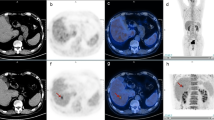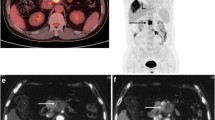Abstract
Purpose
The purpose of this study was to determine the most useful parameter of dual-time-point 2-deoxy-2-[18F]fluoro-d-glucose positron emission tomography/computed tomography (PET/CT) for detection of hepatic metastases in patients with colorectal cancer.
Procedures
Thirty-nine patients had undergone a dual-time-point PET/CT scan and a subsequent histopathological confirmation for a workup of hepatic metastases. Detection rates were compared for visual analysis score, standardized uptake value (SUV), tumor-to-liver uptake ratio (TLR), and percent changes of the SUV and TLR.
Results
Of 91 liver lesions, 86 lesions were confirmed as metastases. The SUV and TLR of metastatic lesions on the delayed images were higher than those on the first scan (p < 0.001). The signal-to-noise ratio of the delayed PET scan was higher than that of the first scan (p < 0.0001). The TLR and SUV of the delayed scan showed the highest detection rates of 92% and 88%, whereas percent changes of SUV and TLR showed the lowest detection rates (51%, 67%). Visual analysis detected 87% on the delayed scan and 77% on the first scan.
Conclusions
A delayed scan is more favorable for the detection of hepatic metastases of colorectal cancer, and the TLR on the delayed scan was the most useful parameter.



Similar content being viewed by others
References
Taylor I (1996) Liver metastases from colorectal cancer: lessons from past and present clinical studies. Br J Surg 83:456–460
Gayowski TJ, Iwatsuki S, Madariaga JR et al (1994) Experience in hepatic resection for metastatic colorectal cancer: analysis of clinical and pathologic risk factors. Surgery 116:703–710
Jatzko GR, Lisborg PH, Stettner HM, Klimpfinger MH (1995) Hepatic resection for metastases from colorectal carcinoma–a survival analysis. Eur J Cancer 31A:41–46
Nakamura S, Suzuki S, Baba S (1997) Resection of liver metastases of colorectal carcinoma. World J Surg 21:741–747
Scheele J, Stangl R, Altendorf-Hofmann A, Gall FP (1991) Indicators of prognosis after hepatic resection for colorectal secondaries. Surgery 110:13–29
Delbeke D, Vitola JV, Sandler MP et al (1997) Staging recurrent metastatic colorectal carcinoma with PET. J Nucl Med 38:1196–1201
Zhuang H, Sinha P, Pourdehnad M, Duarte PS, Yamamoto AJ, Alavi A (2000) The role of positron emission tomography with fluorine-18-deoxyglucose in identifying colorectal cancer metastases to liver. Nucl Med Commun 21:793–798
Rappeport ED, Loft A, Berthelsen AK et al (2007) Contrast-enhanced FDG-PET/CT vs. SPIO-enhanced MRI vs. FDG-PET vs. CT in patients with liver metastases from colorectal cancer: a prospective study with intraoperative confirmation. Acta Radiol 48:369–378
Kim BI (2008) Clinical application of F-18 FDG PET (PET/CT) in colo-rectal and anal cancer. Nucl Med Mol Imaging 42(Supple):52–59
Bipat S, van Leeuwen MS, Comans EF et al (2005) Colorectal liver metastases: CT, MR imaging, and PET for diagnosis–meta-analysis. Radiology 237:123–131
Ruers TJ, Langenhoff BS, Neeleman N et al (2002) Value of positron emission tomography with [F-18]fluorodeoxyglucose in patients with colorectal liver metastases: a prospective study. J Clin Oncol 20:388–395
Brix G, Ziegler SI, Bellemann ME et al (2001) Quantification of [(18)F]FDG uptake in the normal liver using dynamic PET: impact and modeling of the dual hepatic blood supply. J Nucl Med 42:1265–1273
Kubota K, Itoh M, Ozaki K et al (2001) Advantage of delayed whole-body FDG-PET imaging for tumour detection. Eur J Nucl Med 28:696–703
Zhuang H, Pourdehnad M, Lambright ES et al (2001) Dual time point 18F-FDG PET imaging for differentiating malignant from inflammatory processes. J Nucl Med 42:1412–1417
Yen RF, Chen KC, Lee JM et al (2008) 18F-FDG PET for the lymph node staging of non-small cell lung cancer in a tuberculosis-endemic country: is dual time point imaging worth the effort? Eur J Nucl Med Mol Imaging 35:1305–1315
Kumar R, Loving VA, Chauhan A, Zhuang H, Mitchell S, Alavi A (2005) Potential of dual-time-point imaging to improve breast cancer diagnosis with (18)F-FDG PET. J Nucl Med 46:1819–1824
Nishiyama Y, Yamamoto Y, Fukunaga K et al (2006) Dual-time-point 18F-FDG PET for the evaluation of gallbladder carcinoma. J Nucl Med 47:633–638
Inoue A, Tomiyama N, Tatsumi M et al (2009) (18)F-FDG PET for the evaluation of thymic epithelial tumors: Correlation with the World Health Organization classification in addition to dual-time-point imaging. Eur J Nucl Med Mol Imaging 36:1219–1225
Koyama K, Okamura T, Kawabe J et al (2002) The usefulness of 18F-FDG PET images obtained 2 hours after intravenous injection in liver tumor. Ann Nucl Med 16:169–176
Lin WY, Tsai SC, Hung GU (2005) Value of delayed 18F-FDG-PET imaging in the detection of hepatocellular carcinoma. Nucl Med Commun 26:315–321
Dirisamer A, Halpern BS, Schima W et al (2008) Dual-time-point FDG-PET/CT for the detection of hepatic metastases. Mol Imaging Biol 10:335–340
Chen YK, Kao CH (2005) Metastatic hepatic lesions are detected better by delayed imaging with prolonged emission time. Clin Nucl Med 30:455–456
Kuker RA, Mesoloras G, Gulec SA (2007) Optimization of FDG-PET/CT imaging protocol for evaluation of patients with primary and metastatic liver disease. Int Semin Surg Oncol 4:17
Arena V, Skanjeti A, Casoni R, Douroukas A, Pelosi E (2008) Dual-phase FDG-PET: delayed acquisition improves hepatic detectability of pathological uptake. Radiol Med 113:875–886
Hamberg LM, Hunter GJ, Alpert NM, Choi NC, Babich JW, Fischman AJ (1994) The dose uptake ratio as an index of glucose metabolism: useful parameter or oversimplification? J Nucl Med 35:1308–1312
Masuda Y, Kondo C, Matsuo Y, Uetani M, Kusakabe K (2009) Comparison of imaging protocols for 18F-FDG PET/CT in overweight patients: optimizing scan duration versus administered dose. J Nucl Med 50:844–848
Halpern BS, Dahlbom M, Auerbach MA et al (2005) Optimizing imaging protocols for overweight and obese patients: a lutetium orthosilicate PET/CT study. J Nucl Med 46:603–607
Tamaki T, Naito A, Nishio M, Kawahara K (2004) FDG-PET for evaluation of recurrent lymph node metastases in patients with surgically resected breast cancer: adding spot images to whole body images. Breast Cancer 11:60–64
Chin BB, Green ED, Turkington TG, Hawk TC, Coleman RE (2009) Increasing uptake time in FDG-PET: standardized uptake values in normal tissues at 1 versus 3 h. Mol Imaging Biol 11:118–122
Ruers TJ, Wiering B, van der Sijp JR et al (2009) Improved selection of patients for hepatic surgery of colorectal liver metastases with (18)F-FDG PET: a randomized study. J Nucl Med 50:1036–1041
Matthies A, Hickeson M, Cuchiara A, Alavi A (2002) Dual time point 18F-FDG PET for the evaluation of pulmonary nodules. J Nucl Med 43:871–875
Suga K, Kawakami Y, Hiyama A et al (2009) Dual-time point 18F-FDG PET/CT scan for differentiation between 18F-FDG-avid non-small cell lung cancer and benign lesions. Ann Nucl Med 23:427–435
Chen YM, Huang G, Sun XG et al (2008) Optimizing delayed scan time for FDG PET: comparison of the early and late delayed scan. Nucl Med Commun 29:425–430
Acknowledgements
This research was supported by the Pioneer Research Center Program through the National Research Foundation of Korea funded by the Ministry of Education, Science and Technology (2010-0002209).
Conflicts of Interest
The authors declare that they have no conflicts of interest.
Author information
Authors and Affiliations
Corresponding author
Additional information
Significance:
2-Deoxy-2-[18F]fluoro-d-glucose (FDG) PET has been commonly used for detecting hepatic metastases in patients with colorectal cancer. However, FDG PET has limited detection ability for small-sized liver lesions or low metabolic lesions, which could be explained by the relatively high FDG uptake in normal liver tissue and the variable accumulation of FDG in metastatic lesions. For the improvement of the detection ability, a dual-time-point PET scan was designed and showed the high detection rate of liver tumors in several recent studies. However, it is still not clear which parameter of a dual-time-point scan is the most useful for the clinical identification of hepatic metastases. So, we intended to find the most useful parameter in the clinical use of the dual-time-point FDG PET. The results of our study showed that the tumor-to-liver ratio on the delayed PET scan, rather than the changes of FDG uptake and tumor-to-liver ratio, was the most useful parameter for the detection of hepatic metastases. Further, the delayed PET scan made the detection rate of hepatic metastases and signal-to-noise ratio increase.
Rights and permissions
About this article
Cite this article
Lee, J.W., Kim, SK., Lee, S.M. et al. Detection of Hepatic Metastases Using Dual-Time-Point FDG PET/CT Scans in Patients with Colorectal Cancer. Mol Imaging Biol 13, 565–572 (2011). https://doi.org/10.1007/s11307-010-0394-x
Published:
Issue Date:
DOI: https://doi.org/10.1007/s11307-010-0394-x




